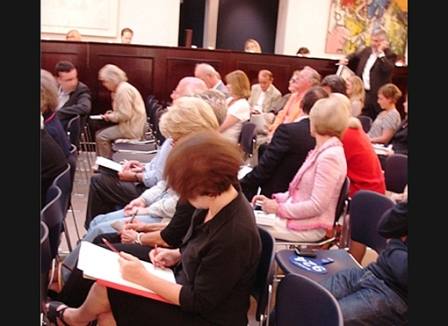ARCO: Feria Internacional de Arte Contemporaneo,
Feb 11, 2009 - Feb 16, 2009
Madrid , Spain
Art & Capital
by María Fernanda Cartagena
SpeculatÄÅnis For over the past decade, Alicia Herrero has been investigating certain operations in the art system whose complexity now suddenly becomes more manifest than ever as we face capitalism’s new crisis in the current phase of globalization. She has dedicated herself to examining how our view of art within specific institutional contexts is mediated and structured by a series of cultural technologies that determine meaning, values and beliefs. She has focused her attention on museum and biennial configurations in order to reveal the mechanisms that regulate the art experience, and by setting into motion a series of exercises in dialogue and processes she has managed to deviate and oxygenize the habitual route taken by institutional practices. She transformed the Museo de Arte Contemporáneo de Rosario into Alice-Ville (2005), a universe of episodes that activated other forms of art production, distribution and consumption. For the Bienal del Fin del Mundo in Ushuaia she organized The Paradigm Confine Tour (2007), an exceptional three-hour boat tour along the Beagle Canal, where paradigms of tourism, science, geography and art floated and fluctuated amidst live music and a theoretical colloquium accompanied by a strong cocktail prepared for the occasion. This unusual scene of convergence brought the debate on the reach of critical art practices in a period of biennialization up to date. Auctions, Market & Money (Art & Capital series) analyzes a quite powerful segment of the art world which promotes consumer culture and art as commodity; this research and documentation offer a view of how the power of its logic winds up distorting other values. Galleries, their maximum expression in art fairs, and auction houses establish certain conditions for the reception of art and thus shape its meaning; Herrero places all this within parentheses in order to suspend its natural course. Regarding galleries, in her essay “Espectadores, compradores, marchantes y creadores: reflexiones sobre el público” (Viewers, buyers, sellers and creators: reflections regarding the public) Martha Rosler observes that these sites respond to a modernist concept of “elevated art” and are removed from any topic other than Art. Rosler states, “The gallery is a secular temple of Art, just as art is essentially the secular substitute for religion.” In these devices and fairs, a similar distance is created between the creator and their production. Once works enter into the free market they acquire an independent life and a power of their own that tends to eliminate any personal relationship. This is the so-called commodity fetish where things possess a life of their own and relate to all other commodities. Art & Capital points out how, in Guattari’s terms, art takes part in capitalist subjectivity’s production machinery by suppressing processes of creative singularization. In spite of current attempts to bolster fairs and art market with other meanings, all the relationships in the indefinite author/work/gallery/fair/public chain pivot around sales and purchases. Herrero positions herself from the standpoint of and within this chain in order to intercept and de-naturalize it (Errata, since 1998). These maps, posters, catalogs, records, video, drawing-documents and certificates translate systems, relationships and circuits where works dance to the rhythm of the capitalist economy. This invisible hand also traces maps and geographies of cultural globalization and the internationalization of art that establish new forms of domination. This is why the topography of China, Map (2006), is delineated by means of data and figures from the latest Sotheby’s auctions, culled from the Internet. In order to reinforce this exploration from a different perspective, Herrero camouflages herself in Suite Auction Drawings (since 2008), becoming an eyewitness who captures the climax of an art auction, one of the most powerful scenarios of economic transactions. Her visual-documentary essay is the result of a detective’s gaze, analysis and theorizing regarding procedures that are innate to the capitalist system and tend toward obtaining a profit. After all, whatever facilitates business facilitates speculation. For this research, Herrero re-appropriates tools such as cartography, statistics, record sheets and other forms of registration, supervision and power. Her research methodology is uncommon, meticulous and obsessive. She mixes dissimilar languages with precision in order to construct visual instances that dissolve classic divisions regarding what is considered to be subjective or objective, between what is real and what is fictitious. Her exhibition purposefully creates a zone of dissent within a powerful camp of strength through the political use of space and humor, she turns the viewer’s gaze back to the very place where he or she is positioned and on the operations at play. This living archive, in the eye of the hurricane, manages to activate poetry’s indissociable political dimension. February 2009 María Fernanda Cartagena, independent curator and researcher.
|













